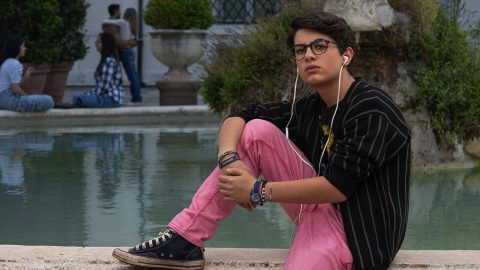Middle school can be a nightmare, especially for queer kids — or anyone who dares to be different. It’s a formative time when social groups solidify and identities start to stick: jocks become jocks, nerds become nerds, and so on. Margherita Ferri’s The Boy with Pink Pants (2024) focuses on the short life of Andrea Spezzacatena, an Italian teenager who tragically took his own life after relentless bullying at school and online.
The film explores the interconnected events that shaped Andrea’s struggles, from his parents’ divorce to a complicated, mostly platonic love triangle with two classmates — one of whom ultimately betrays him in a moment of devastating cruelty. With compassion and a desire to educate audiences on the consequences of seemingly normal juvenile teasing, Ferri brings attention to a story that not only made headlines across Italy but also drove Andrea’s mother to write a book about his life and become a full-time anti-bullying advocate.
The film opens with Andrea’s first day on earth, as his mother Teresa (Claudia Pandolfi) gives birth in the hospital. From beyond the grave, Andrea’s narration frames the story: “I’d be 27 today. I wonder what I would have become.”
While narration can sometimes feel like a lazy storytelling device, here it adds an immediate and haunting weight to the film. Hearing Andrea reflect on his life from the afterlife sets the tone for the heartbreak that follows.
We jump forward to Andrea’s teenage years. His life isn’t perfect, but it’s not unusual either. The biggest problem is his parents’ crumbling marriage — sometimes their arguments get so intense that Andrea and his little brother escape to a nearby bookstore for some peace. But beyond that, Andrea seems to have enough going for him that you wouldn’t immediately suspect him of being suicidal. He has a loving, supportive mom, musical talent and hobbies like jogging and going to the cinema.
While Ferri’s approach occasionally veers into sentimentality (the repeated use of “Ave Maria” stands out), she has an exceptional gift for capturing the complex way teenagers communicate and wrestle with their insecurities. Take Andrea, for example: he starts acting out in class to impress Christian (Andrea Arru), his handsome, charismatic new classmate.
At first, it’s unclear whether Andrea feels a romantic attraction to Christian or just admires him as the kind of cool guy a self-proclaimed “nerd” would love to hang out with. Either way, being around Christian makes Andrea feel safer, more confident. When you’re with the popular kids, it’s like having a shield against all the social humiliations of high school. You start to believe, “If these guys like me, maybe I’m not such a loser after all.” But that fragile confidence leaves Andrea vulnerable to a devastating fall — the kind of traumatic public humiliation that calls to mind Brian De Palma’s Carrie (1976). Watching Andrea’s heartbreak unfold is gut-wrenching, especially since we know there’s no cathartic revenge waiting for him at the end.
Ferri also captures how kids who feel excluded tend to find each other, forming tight-knit friendships often built around a shared love of the arts. Andrea and his best friend Sara (Sara Ciocca) bond over their trips to the cinema, which might seem a bit repetitive but feel deeply authentic. For many queer teens, these art-driven connections are a lifeline — not just a way to get through tough times but a glimmer of hope that there’s more to life than teenage angst and nonsense. Ciocca’s performance brings depth and heart to Sara, steering her character away from the stereotypical “straight friend” trope.
You’re probably wondering about these pink pants1Despite being American English, we use “pants” instead of “trousers” to stay consistent with the film’s title. by now — they don’t show up until halfway through the film, and their role is surprisingly nuanced. At first glance, you might think they’re a bold statement from a confident queer teen — a kind of “I don’t care what anyone thinks; this is me.” For Andrea, the story is much more accidental. His mom ruined the pants in the wash, turning them from maroon to bright pink. Andrea simply likes the pants and decides to wear them to school. The problem isn’t the pants — it’s his classmates, who can’t handle the sight of a boy in pink.
This twist makes Andrea’s connection to the colour feel casual rather than defiant, which ironically leaves him even more vulnerable. The bullying he faces isn’t just about his uncertain sexuality; it’s about how his cruel, unpredictable peers latch onto any excuse to make him a target.
At just under two hours, the film begins to feel a bit stretched toward the end, but Ferri treats Andrea’s tragic death with a great deal of sensitivity, choosing to keep the suicide offscreen. This thoughtful decision avoids sensationalism, showing that it’s possible to explore the pain of queer-adjacent experiences without exploiting their most shocking aspects. Rather than focusing on the tragedy itself, the film shows the beauty and depth of the life that was lost, reminding us of the person behind the headlines.
Editor-at-large Jared loves movies and lives with Kiki in Berlin.

